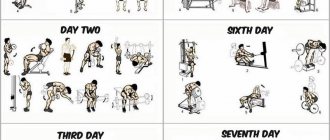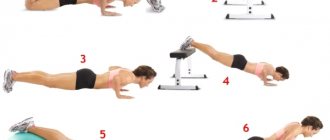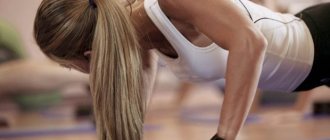This article is intended primarily for young people of pre-conscription age who will undergo military service in the next year or two. Here you will find a description of a whole arsenal of athletic and other exercises that will help pre-conscripts meet the requirements of various branches of the military. Among other things, you can get an idea of the nature and intensity of the loads that befall a serviceman, as well as get acquainted with practical advice regarding service in the Russian army.
Army exercise
What is a modern military-style charger? Exercise is, perhaps, a mandatory element that awaits a young warrior in any place and in any army, wherever he happens to serve. Probably, some of you are doing several gymnastic exercises even without our advice. But military exercises are completely different. It lasts at least 30 minutes, but, for example, for paratroopers and marines it usually takes about an hour. Army charging does not exist as something immutable, established once and for all. If we schematize it, it consists of the following three unequal parts that make up a single whole and ensure an increase in load (intensive segment, culmination and gradual decline): warm-up exercises (walking, slow running, general developmental exercises for the arms, body and legs, performed in motion ); energetic general developmental exercises, exercises with weights, on gymnastic equipment, exercise machines, together with a partner, jumping and overcoming obstacles, cross-country races of varying lengths or accelerated movement across terrain at a distance of up to 4 kilometers; calming slow running, walking combined with breathing exercises and muscle relaxation exercises. Within this general scheme, several charging options are used. First option. Multiple repetitions of general developmental exercises at an increasing pace (in combination with floor exercise complexes). In addition, the first option provides: exercises with a partner; special exercises (head rotations, jumps with turns, imitation of punches and kicks, somersaults, etc.); swimming, sports games, running 1000 -1500 m. As an example, army physical training specialists recommend the following charging scheme: walking with gradual acceleration of 50 - 60 meters; slow run of 400-500 meters; fast walking with a gradual slowdown of 100 - 150 meters, performing exercises for the muscles of the arms, torso and legs in motion; first set of floor exercises (repeat 4 times without a break); lying push-ups (15 times); exercises performed together (2 - 3 minutes); 2 - 3 exercises for the muscles of the arms and shoulder girdle (20 times each); second set of floor exercises (4 times); jumping in place (40 - 50 jumps); walking 400 meters in combination with exercises performed in motion; 1500 meter run (9 - 10 minutes); walking 150 - 200 meters in combination with muscle relaxation exercises. If there is a body of water nearby, in summer you can swim an additional 200 - 250 m. Second option. It focuses on athletic exercises performed with weights. It can be supplemented with exercises on simulators, gymnastics and special equipment. The exercise ends with a run of 1000 - 1500 m. The third option. It is based on overcoming obstacles. This is preceded by fast walking, running 400 - 500 meters, and preparatory exercises. The latter can be replaced by imitation of blows and hand-to-hand combat techniques. The number of obstacles is selected so that it takes no more than 25-30 seconds to overcome them. At the end of the exercise, use a 1000 m run. Fourth option. It includes speed running, relay races, accelerated movement, in which fast walking of 200 - 300 m alternates with running of 800 - 1200 m (up to 4 km is possible). Example: Shuttle run 10X10. It is carried out on a flat area, marked with start and turn lines every 10 m. At the command “March!” from a high start, run 10 m, touch the ground behind the turn line, turn in a circle, run in the same way for another nine segments of 10 m. Ratings: satisfactory - in 29 seconds; good - 28; excellent - 27. All this ends with a cross-country race of one to three kilometers. The above charging options can be diversified with a whole range of other loads: special running exercises, which use starts and accelerations over distances (up to 100 m); exercises performed on gymnastic and special equipment and simulators; overcoming certain sections of the obstacle course while simultaneously performing hand-to-hand combat techniques; running 3 - 4 km.
How to prepare yourself for the army
First, about how I personally prepared for the service. The starting point for me was the decision to go to serve. I accepted it about six months before conscription and I think that this is the most important thing - to internally reconcile myself with the boots of a soldier. Neither physical preparation, nor smart plans and arrogance, nor “hairy paws” - all this does not matter if you do not decide in advance: your personal decision is voluntary - what is it? I decided on the wording of mine as follows: “If I’m fit for health reasons, then I’ll go walking and digging.” I calculated approximately October 15 as the date of my conscription, and from these calculations I began to prepare. The first preparation points were:
— I met everyone I wanted to meet; - completed all unfinished tasks; — wrote down 5 possible future places of employment; - I finally radically resolved the issue with the massive amount of junk on my computer - I just deleted half of it to hell; — I got acquainted with what network resources give us to understand the army, of which Lurkmoar singled out. All kinds of “committees”, “bar associations” and so on seemed to me crazy nonsense at the time. After serving, I realized that I was right; — got acquainted with the stories of my father and grandfather on the topic of the army; — I spent a lot of time getting into the heads of my acquaintances, friends and relatives that I don’t need any money and I’m definitely going to serve. Thanks to everyone who supported me, helped me, and was perplexed. Then, having completed all of the above and visits to doctors, I developed a preparation plan, where I focused on psychological and moral preparation. Even now I believe that this bias is correct, but I regret that I did not pay enough attention to physical training. Psycho-moral training consisted of psychological attunement to service, long observations of the behavior of various young people in various places: street punks, alcoholics at the store, pretentious comrades choosing an iPhone for themselves. In addition: studying your own medical history and using relevant video, audio and text materials. My physical training consisted of weekly runs three times a week for a kilometer, along the way squats 30-40 times, pull-ups 5-7 times (it was cold and there was already snow, by the way). All this turned out to be unspeakably not enough. But there were also encouraging moments in addition to psychological preparation - this was combat training. With some unknown feeling, I felt that I needed to train in this direction, and for the whole month before the conscription at home, I raised one leg, then the other by 10-15 cm and held it straight, trying to maintain balance and a straight back - these are not tricky exercises subsequently allowed me to feel confident on the line. Where others fell, tangled, splashed with tears (!) from holding their legs for 2-4 minutes, I did not have a single (!) reprimand for drill throughout the entire training.
Summing up the story of my preparation, I am forced to note that it was correct in places, but overall not entirely adequate. Now, after long observations, some tests and numerous comments, I can explain to everyone who is interested how to prepare yourself for the army so as not to get into trouble. 1. Important decision The main thing is that you need to clearly and definitely understand why you are joining the army. It’s one thing to whine that the bloody regime is forcing you, and completely another thing to realize that you need it. Your actions and attitude will largely depend on your initial decision and strengthening yourself in it. You shouldn’t waste time convincing your friends and everyone around you that you are going to serve for some other reason than “you don’t have money, or what?” - You can convince them, but you don’t need it. Relatives and friends will understand you immediately, after the first serious conversation. Next, you should finish all your work. Important things that you have time to finish, you must finish - no “later”. If you can’t finish it, don’t find the time, forget about it forever, which means you don’t need it for nothing. The surest, albeit scary, thing is to understand what you would do if you were going to die: say what you need to the right people, shake the hand of someone you need, write a letter to your long-forgotten grandmother, throw away your cherished children’s toys, impose totalitarian order on the assigned territory... Next, you need to find out as accurately as possible where you will be sent based on objective data - health, origin, nationality. After this, it is necessary to begin priority activities. 2. What to do right away? You should start by preparing the legal framework for the military registration and enlistment office and understanding where you yourself would like to go to serve. At this stage, it is necessary to clearly understand that it is too late to rock the boat. Searching and collecting information about yourself is what you really need. All illnesses, sores, personal specific skills that are useful in the service, the experience of friends, father, grandfather, brothers. The legal basis is: Federal Law “On Military Duty and Military Service”. For some reason, no one bothers to study it, but the military registration and enlistment office is full of juvenile experts on what they are “obliged” to do and what someone “has no right” to do... Next, there is a problematic issue that absolutely needs to be solved – the girl. If you have a wife, then she is unlikely to go on a spree with someone or suddenly fall out of love; as a rule, such examples are one in a thousand, but a girl is the cause of a ton of problems. Therefore, you need to understand whether you love her or not, and ask her this serious question - the answer must be sure and clear. If you don’t love or she doesn’t love you, feeds you breakfast and avoids a direct answer, break up with her. While you are in the army, such an undecided 99% will abandon you, having first cheated on you - this is simply a fact of existence. It’s painful, it’s difficult, but now it will be easier for you than when you received an interesting letter in the army, which for some impressionable people is a reason to beat someone up, break something, or shoot themselves on a guard tower. The political officer may even understand, but he won’t be able to help in any way - and because of your unjustified hopes, you may end up in jail, or even worse. Therefore, the principle is: if one of you doesn’t like someone, leave!
The girl must understand that “wait” and “wait for DMB” are two different things. And if she “loves”, but “is not ready to wait,” then it’s all the more worth getting rid of her.
If you are lucky and everything is fine with you, then you should absolutely not promise her anything: letters, calls, texts for the night. You can be taken to hell, your phone can be taken away, you can lose it, you will spend two weeks trying to find out the postal address of the unit, in general - anything. Service. The only thing you can promise is that you will contact her as soon as possible. 3. Moral and psychological preparation Moral psychosis for you should consist of self-attitude and understanding of the details of the male team, army service, “concepts” and roles of behavior. All this is described in the epic books of Ortega y Gasset, Le Bon and all sorts of Freuds. It’s clear that you can’t even comprehend all this in the course of a human life, let alone in a couple of months, so you need to spend time before going to bed in the evenings in civilian life with intelligence and ingenuity. List of what must be consumed before serving in the RF Armed Forces (in my opinion):
— movie “Experiment”; — the film “Small Earth”; — movie “Full Metal Jacket”; — movie “DMB”; — series “Soldiers”, only the first season; — series “Storm Gates”; — the film “Guard”; - the film “The Unthinkable”, in order to think carefully about whether you can pull the trigger when necessary; — the film “Starship Troopers”; — the film “300 Spartans” is the anthem of the professional army; - book “The Adventures of the Good Soldier Schweik”; — book “Painted”; — books by Vasil Bykov; — book “Confession of a conscript serviceman”; — book “Kirza”; - all possible songs about the army, starting with LYUBE and ending with Soviet ones. All this is more than enough. Your task is to increase your knowledge and learn in various situations how to behave more effectively and how to quickly show complete strangers, but necessary and intelligent people, that they can deal with you and can rely on you. Remember: when you come to someone else’s monastery, you shouldn’t bring your own samovars. It's better to collect them locally. 4. Physical training Physical training should be given close attention after you have collected all the data on your sores and shortcomings. Be clearly aware of your limits: smoking bothers you – quit! Don't have time to play games on the computer? Remove everything except MS Office. Find time for physical exercise.
What you need to train first: endurance and lifting capacity. Endurance is trained by running, squats and breathing exercises. Load capacity: horizontal bar, dumbbells, barbell. In no case should you pretend to be Rambo, start small, but be constant - every day, but a little much better than once a week, killing yourself with a forced march through the mud. You should start pumping up your endurance with 100-meter timed runs and a kilometer of running at a calm pace. Here is an approximate starting minimum for endurance: running at a calm pace for 200-300 meters, squats 20-30 times, running 700-800 meters, speed running for a hundred meters.
Second level: calm running 400-500 meters, 30-40 squats, running 800-900 meters, speed running 100 meters.
Level three: calm run 1000 meters, 40 squats, speed run 100 meters, calm run 1000 meters.
Level four: calm running 1000 meters, goose step 50-60 meters, 20-30 squats, average running - 500 meters, shuttle running 2-3 times 20 meters.
The highest level of pre-conscription physical endurance training according to general impressions:
— 30-40 squats with a minimally knocked down “breath”; — 2-3 km at an average pace; — “goose” step of 50-60 meters; - shuttle run 3-4 times 20 meters; - 100-meter dash in 12 seconds or less. Now regarding the carrying capacity – why is it needed at all? Doing 400 push-ups and 25 pull-ups is all fun, but it doesn’t happen as often as carrying your PKM and running around in a bulletproof vest with all the OZK and your own Kalash. Load capacity is primarily physical strength and the ability to carry heavy objects for a long time.
Homemade dumbbells of 3 kg, a barbell of 10 kg per plate and 5-7 “clean” pull-ups on the horizontal bar - this is your start. If you already know how, well done, if you don’t know how, you must reach this minimum.
Second level: dumbbells 3 kg, barbell 20 kg, pull-ups 7-9 times.
Third level: dumbbells 4-5 kg, barbell 30 kg, pull-ups 10 times.
Level four: dumbbells 4-5 kg, barbell 40-50 kg, pull-ups 12-14 times, parallel bars - full pass.
The highest level of pre-conscription physical training of carrying capacity according to general impressions:
— dumbbells 5-7 kg; — barbell 50-70 kg; — pull-ups 15 or more times “clean”; — full passage of bars on hands 20 meters; - “swing” on uneven bars – 12-15 times. Let me emphasize once again: it is extremely important to observe moderation and consistency, because you will end up in the army looking like a jock and on your first run in the frost of one and a half kilometers you will die in a snowdrift. Another important element of physical training: drill. First, practice keeping your balance on one leg, then on the other, then balance with your legs straight while lifting either your left or your right to a height of 10-15 cm from the floor. Practice the stand itself: try to just stand straight with your back as straight as possible for 2-3 minutes without moving or scratching yourself, then ask someone to help: let them make you laugh, show you some crap, blow, bite your cat - you must save equanimity - even turning your head or trying to blow on your sweaty forehead is already a failure, all over again. It’s worth walking along the street for some time with the hand signal, so that the body gets used to moving the corresponding hand to the corresponding leg: the right leg goes, the left hand goes in front and vice versa. 5. Intellectual preparation Your IP for the army is the study of the performance characteristics of small arms, rifles and grenade launchers, grenades and body armor adopted by the RF Armed Forces. Almost all data can be found in the public domain. Believe me: you will be much more comfortable if you study in advance the main characteristics of AK, SVD, AGS, RPG and various RPKs. This knowledge will greatly help you become a “steering wheel” and spend more time on other things than sitting on the “take-off” and cramming, feeling awkward and resentful, as if you were sitting at a school desk. The second part of the IP is the OVU, general military regulations. You shouldn’t even pick up the Charter of the Guard Service or the Disciplinary Code - you don’t need all this yet. You need to review and, if possible, understand the main provisions of the Internal Service Charter and the Drill Regulations. The most basic concepts: what is a combat step, rank, formation, how movement occurs in formation with and without weapons, what are the combat commands, discipline and unity of command, army ranks and positions, what is and why is a daily outfit assigned, duties and responsibility of the orderly and company duty officer. During your service you will have to learn a ton of everything, especially if you want to be something more than just give or take: go on guard, become a paramedic, a company duty officer, a checkpoint officer or a shift operator. Be prepared for this from the beginning - familiarize yourself with the basics. And you will understand in advance that if the army “stupefies” anyone, it is clearly not the one who prepared in advance. 6. Routine preparation of the RP is the organization of your day. Gradually come to the parameters:
— getting up at 6-7 am, light exercise; — breakfast 8-9 a.m., no matter what the conditions; — lunch at 13-14 pm; — daytime rest in a lying position from 14 to 15; — dinner 19-20 pm; — lights out at 22-23 pm. Try to include the simplest foods in your diet - white bread, buckwheat, pasta with stewed meat. You can eat hamburgers and ice cream on the farewell, but two or three weeks before the army, start to give up fast food and all kinds of office and student food. Here is a comprehensive guide to self-study. For those who don’t want to read so much, below is a table of symbols that you need to “pump up” before the service. - ENDURANCE. - KNOWLEDGE OF WEAPONS' performance characteristics. - COMMANDER'S VOICE. — COMMON MILITARY REGULATIONS. - HARDNESS. — VIgilance. — KNOWLEDGE ABOUT THE OPERATION AND REPAIR OF GARDEN AND CLEANING EQUIPMENT. — COLLECTIVISM. — KNOWLEDGE ABOUT COMPUTERS. Level 1: word, excel. — KNOWLEDGE ABOUT COMPUTERS. Level 2: word, excel, power point, how to fix software problems, install the system and programs, determine the cause of hardware failure and what exactly is broken. — KNOWLEDGE ABOUT COMPUTERS. Level 3: have all the above skills, as well as skills in Adobe Photoshop, Corel Draw, know Excel formulas, and be super smart. — ACCURACY. - MECHANICS. What and how to fix: from a tape recorder to a UAZ. - MUSICAL INSTRUMENTS. Guitar, drum, harmonica, and damn even a saxophone will be useful, I guarantee it. - TO THE START. Be able to quickly return the arrangement of things, your appearance, specific documents or things to their original position, without asking any questions. — REPAIR OF UNITS. Level 1: ability to hem, patch holes and sew on buttons. — REPAIR OF UNITS. Level 2: ability to hem, patch holes and sew on buttons very quickly. — REPAIR OF UNITS. Level 3: the ability to hem, patch holes and sew on buttons in seconds, know the location of insignia, be able to sew on chevrons and make urgent repairs to any attached clothing. - TELEPORT. Appear instantly when your boss calls you. - SAFETY. Know the safety requirements when working on roofs, in abandoned buildings, near electrical installations and with sensitive equipment. - DARK NIGHT. Don’t lose your ability to work at night, be able to rest every free minute you have. - NOT IN DEBT. To be able to live on a minimum amount of money, nowadays with a soldier’s military salary exceeding a thousand rubles, is simple and commonplace. But not everyone succeeds: in the end, maybe it was worth buying a military uniform? - HARDENING. Level 1: calmly wash your hands, face, brush your teeth and shave in cold water. - HARDENING. Level 2: you can take a cool shower, you feel confident in a tracksuit outside at minus 10-15. - HARDENING. Level 3: you can wash yourself with cold water, falling naked in the snow is far from a tragedy for you, you know how to wash clothes in cold water and quickly restore blood circulation in your legs and arms.
psi_overlord
You can read the original post by blogger psi_overlord with comments from readers of his blog here.
Send stories about how you tried to get help from the Russian state during the coronavirus crisis and what came of it to [email protected]
https://youtu.be/f_bWLxrciLc
Checking and assessing strength readiness
Now, get acquainted with the standards for testing and assessing strength and endurance that the Armed Forces require of young recruits to military units.
Checking and assessing the strength readiness of military personnel is carried out on the basis of the Manual on Physical Training, put into effect in 1987. This document defines control exercises and standards, as well as the procedure for conducting control checks.
To assess the strength readiness of military personnel, 4 control exercises were selected:
- pull-up on the bar;
- lifting by coup;
- lifting a 24 kg weight sequentially with each hand without rest for the number of times; in this exercise, two weight categories are established (70 kg and over 70 kg), the minimum number of lifts of the weight with the weakest hand is 8 and 12 times, respectively;
- complex strength exercise: the maximum number of torso bends forward from the starting position lying on the floor, hands behind the head until the hands touch the toes for 30 seconds, followed by bending and straightening the arms in a lying position also for 30 seconds.
What do you need to know before joining the army?
Army – development of patriotism. It is important to understand that in the service you cannot do without responsibility. Staying in the barracks means relationships with comrades. Relationships can be strained or fraternal. It is better not to get into conflicts and not get into trouble.
They say that in the army you don’t need to think, but this is far from true. Intelligence has always been valued among soldiers, so a young man must be able to take initiative, show his skills and abilities in military matters.
You can independently study the types of weapons and get acquainted with the regulations. Men are always marked by the commander. In the future, the young man can serve under a contract, so there is no need to hide his skills.
It is also better to think about where the young man would go to serve. You must inform the military registration and enlistment office of your desire during the draft.
https://youtu.be/D1n22Nw3k0E
Control standards for assessing the strength readiness of male military personnel.
| No. | Test exercises | Young replenishment of military units | |||
| excellent | choir | beat | |||
| 1 | Pull-up on the bar | 12 | 10 | 7 | |
| 2 | Lifting by coup | — | — | — | |
| 3 | KSU | 48 | 44 | 40 | |
| 4 | Lifting 24 kg kettlebell | Up to 70kg | 32 | 30 | 26 |
| St 70kg | 40 | 38 | 34 | ||
For young recruits, these standards are slightly reduced.
How to learn to do pull-ups on the bar
Pull-ups on the bar from hanging on straight arms are a rather difficult exercise, during which you need to lift your own weight up to 15 times to almost a meter height. The pull-up is counted if the chin rises above the bar, and the hanging position is then fixed for 1 - 2 seconds. Whip-like movements of the legs are not allowed. Bending and spreading your legs is not considered a mistake.
This exercise involves the muscles of the arms, shoulder girdle, back and abdomen. The main load falls on the biceps, the inner heads of the triceps of the shoulders, the pectoral and latissimus dorsi muscles, as well as the deltoids, forearm muscles and abdominal muscles. Therefore, sets of strength exercises must necessarily include exercises aimed at strengthening these muscles.
But the most effective exercise for preparing for the test is, of course, the pull-up itself on the bar. To successfully master physical training standards, it is necessary to perform a certain amount of load. Practical experience shows that the weekly volume of the total number of pull-ups should be 60 - 100 times. This is a rather difficult task that only well-trained people can solve within 2 to 4 weeks of training. A low initial level of fitness requires a gradual increase in the volume of the training load: from 20 to 30 repetitions per week with a gradual increase to the specified values.
Insufficiently prepared people need to perform sets of general strength exercises 2-4 times a week in the first month, gradually increasing the volume of strength load, and only after that can the number of pull-ups be increased. The time required to prepare for the test session can be 6 - 8 weeks or more.
In the first 2 - 4 weeks, it is effective to use pull-up exercises with the help of a partner or on a special machine with a facilitating counterweight: up to 10 - 15 times in each approach. Such work stimulates not only an increase in strength and strength endurance, but also increases the mass of working muscles. As the level of fitness increases, classes include 2 to 4 sets of pull-ups with additional weights from 2.5 to 5.0 kg with a number of repetitions from 1 to 5 times. It is advisable to diversify pull-ups by changing your grip on the bar with your hands in each series of exercises.
The level of preparedness achieved during training is much easier and more beneficial for the body to constantly maintain than to periodically “catch up” with training. The volume of "maintenance" load is usually from 40 to 60 repetitions per week.
To calculate the volume of training load in classes, you can use the table data. Planned volume of physical activity in a training session when performing gymnastic strength exercises (according to V.V. Mironov et al., 1987)
| Maximum result | Planned load (number of repetitions X number of approaches in the lesson) | ||
| Pull-ups, dips on parallel bars, straight leg raises to the bar | Lifting by coup | Lifting by force | |
| 1 | 1X7 | 1X6 | 1X3 |
| 2 | 1X8 | 1X7 | 1X5 |
| 3 | 2X6 | 2X5 | 2X5 |
| 4 | 2X7 | 2X6 | 2X6 |
| 5 | 3X6 | 3X5 | 3X5 |
| 6 | 3X7 | 3X6 | 3X6 |
| 7 | 4X7 | 4X5 | 4X5 |
| 8 | 5X6 | 5X5 | 5X4 |
| 9 | 5X7 | 5X6 | 5X5 |
| 10 | 6X6 | 6X5 | 6X5 |
| 11 | 6X7 | 6X6 | 6X5 |
| 12 | 7X6 | 7Х5 | 7X4 |
| 13 | 7X7 | 7X6 | 7Х5 |
| 14 | 8Х7 | 8Х6 | 8Х5 |
| 15 | 9X7 | 9X6 | 9Х5 |
Rest intervals between sets are 1 - 3 minutes, and the total workout duration is 10 - 20 minutes. The required frequency of such training is up to 3-4 times a week.
When performing exercises with the help of a partner or on a machine with a facilitating counterweight, the number of repetitions of the exercise increases by 20 - 50%.
The main emphasis in the physical training of young soldiers will be on team sports
Last week, information worthy of an April Fool's joke leaked from the Ministry of Defense: it was reported that in 2012 the military department would purchase about 10 thousand badminton rackets and tens of thousands of shuttlecocks. In addition to the massive purchase of equipment, it is planned to create an infrastructure for badminton classes. Snipers will be the first to master the new army sport. The correspondent of “Our Version” decided to find out what other changes have occurred in the system of physical training in the Russian army.
The Russian Ministry of Defense quickly denied this message. Official representatives of the military department were “surprised” by the information about plans for the development of badminton in military units; it was noted that this sport “is not included in the physical training programs of military personnel.” However, it is not surprising that this ambiguous message was taken on faith, because a few days earlier the Russian President called on Russians to actively play the “wonderful game” of badminton, and the military was accustomed to taking seriously the advice of the Supreme Commander-in-Chief.
For the first time in the history of the Armed Forces, platoons of physical training instructors were formed, consisting of 10 to 15 people. The positions of instructors in hand-to-hand combat, overcoming obstacles and mountain training, accelerated movement, ski training and orienteering were introduced
Apparently, this is why military commanders at all levels began vying to praise this sport, which “is very useful for all fighters without exception, since watching the shuttlecock trains the eye muscles, strengthens the cardiovascular system and develops reaction speed, and when playing, the same muscles are used as when throwing grenades and knives."
The head of the Center for Military Forecasting, Anatoly Tsyganok, told Our Version that he doubts the ability of badminton to displace traditional sports from the army, since playing with a shuttlecock does not develop the qualities necessary for a soldier, such as athleticism, speed and the ability to act in a team. The expert suggests that the attempt to introduce badminton into the army was pursued by some opportunistic considerations; the military wanted to please the president, and against this background, extract an additional budget.
“Today the actions of Defense Minister Anatoly Serdyukov are very similar to the actions of Marshal Zhukov, who in the early 50s imposed a game of gorodki, which was useless from the point of view of military physical training.”
Meanwhile, recently physical training in the troops has really undergone significant changes. It is surprising that Anatoly Serdyukov began to instill interest in sports in the Ministry of Defense in the military. With the arrival of Serdyukov, certification commissions in military units and formations began to consider physical fitness the most important indicator of the successful performance of official duties. It should be noted that from the point of view of the governing documents regarding physical training in the army, everything was quite strict before. The instructions of the defense ministers of the Soviet era clearly required officers and generals to devote four hours of their official time weekly to sports and physical training. But most of these orders were ignored with the same ease with which they were issued.
The new minister decided not to repeat the mistakes of his predecessors. For the first time, it was decided to carefully check the level of physical fitness of the troops. The assessment was given by “independent experts” from the Main Directorate of Combat Training and Troop Service, as well as the Sports Committee of the Ministry of Defense, which was reassigned directly to the Minister of Defense. High-ranking generals were the first to come under fire from inspectors. All commanders of armies and flotillas were gathered at the stadium of a separate motorized rifle brigade in the Moscow region and everyone was forced to pass the standards. In order for them to feel the seriousness of the new approach to physical training, those who could not cope with the standards were immediately nominated by the certification commissions for transfer to the reserve. Legally, the argument was weighty: if you do not comply with physical training standards, you are not ready to fully fulfill your job responsibilities.
On this topic
1881
The Russian Ambassador to Turkey reminded Russians of the dangers on vacation
Russian Ambassador to Turkey Alexey Erkhov listed the main dangers that tourists may encounter while holidaying in this country. He paid attention to the climate, city traffic and alcohol abuse.
At the beginning of 2008, they began to consistently check the level of physical fitness of generals and officers of all main and central departments, military universities and troops of military districts. As a result, it was possible to obtain a complete picture of the physical weakness of the Armed Forces. The conclusions of the commissions really turned out to be disappointing: every fifth officer was rated “unsatisfactory”, more than half barely reached the “three”. Inspections of military educational institutions also did not inspire optimism; more than 10 military universities showed “unsatisfactory” results. 12% of combat regiments and brigades were also rated unsatisfactorily, and 60% of units and formations barely achieved a “C”.
The scale of the disaster in the army and navy was such that the Ministry of Defense was forced to take drastic actions. In military units and formations, in applied military swimming and light diving training, in athletic training, in practical shooting from small arms and throwing grenades. And even for survival in extreme situations.
It should be noted that today the career growth of each officer directly depends on the level of physical fitness. Now in the personal file of military personnel there is a section where the results of the standards are recorded. Taking them into account, certification commissions make decisions on career advancement. In addition, if an officer is lagging behind in sports, he is not paid the substantial bonuses that are provided for by Orders of the Minister of Defense No. 400 and 1010. Also encouraging physical training is Order No. 1115, which allows military personnel rated “excellent” to be paid significant monthly increases. Moreover, if an officer regularly confirms the title of master of sports, then the amount of his bonus increases to 300% of the salary for a military position.
Conscripts will also have to do more sports in the near future; the total number of hours of physical training has been increased to 25 per week. According to the Ministry of Defense, “in order to instill in conscripted military personnel a love of sports and a desire to voluntarily improve their athletic performance, most of the classes will be held in a playful and competitive form.” And, perhaps, the most revolutionary decision is that for the first time in the history of the Russian Army, conscripts were allowed to exercise in sportswear and shoes.
In 2011, an experiment took place in the Taman brigade, which was supposed to test a new physical training system. Soldiers and officers were engaged in physical education for six months, training five hours a day. The military had the opportunity to engage in various sections: weightlifting and athletics, volleyball, football, basketball, hockey, and women’s fitness. It is planned to extend this experience to all Armed Forces.
The Ministry of Defense has also taken up the construction of universal sports complexes, where about 200 people can train simultaneously. By 2012, 26 such complexes will be built. Four are already ready in Ryazan, Voronezh, Tula and the Moscow region, and construction of two complexes is underway in the Murmansk region. The reform of the physical training system is producing real results; an obscenely fat general in the army is today rather an exception to the rule. The military department notes that over the past three years the level of physical training in military structures has increased by one and a half times. However, according to experts, all these figures are somewhat overestimated. First of all, because the new manual on physical training in the Armed Forces (NFP-2009), on the basis of which physical training is organized today, has significantly lowered the standards. For some age groups, challenging exercises such as pull-ups have been replaced by push-ups. According to Anatoly Tsyganok, now there is a return to the norms of the USSR army, when much more time and money were devoted to physical training. However, as our interlocutor emphasizes, there are obvious excesses. For example, fairly advanced Soviet methods of physical training are poorly used, new sports towns are being built, and old ones are falling into disrepair.
“But it should be noted that the level of physical fitness in the Russian Armed Forces remains lower than in Western armies. Indeed, today the standards have become almost identical to NATO, but we must not forget that, for example, contract soldiers of the American army must pass all standards with excellent marks, otherwise their contract may be terminated. I have great doubts that Russian officers and soldiers today will be able to achieve such results,” says Anatoly Tsyganok.
How to learn to do an inversion lift
This exercise is performed on the bar from a hanging position with an overhand grip. You need to pull yourself up slightly, raise your legs to the crossbar and, turning around it, come out with straight arms. The position of the hang and support is fixed on straight arms for 1 - 2 seconds. You can lower yourself and hang in an arbitrary manner. Whip-like movements of the legs are prohibited. Leg bending and spreading are allowed.
This exercise characterizes the level of general strength preparedness of the muscles of the arms, shoulder girdle and torso.
The exercise as a whole and training in it usually do not cause difficulties if the standard for pull-ups is met, the abdominal muscles and back extensors are well developed. Improving technique significantly increases performance by improving intermuscular coordination and economizing effort. To calculate the training load in classes, you can use the recommendations in the table.
If you find it difficult to perform this exercise and do not meet the regulatory requirements, then begin to increase the total number of repetitions of this exercise in training sessions, during morning physical exercises, and also increase the total volume of strength load through other exercises. Usually, after two months of focused work, passing the control standard no longer causes any particular difficulties.
Complex strength training
A complex strength exercise is performed for 60 seconds: the first 30 seconds - the maximum number of bends forward until your hands touch your toes from a lying position, the second 30 seconds - the maximum number of push-ups while lying down. This is a typical strength endurance exercise that requires specific training. When bending the body, the flexor and extensor muscles are alternately activated, which, as a rule, do not experience such a load in everyday life.
This part of the exercise can be trained separately, first performing exercises at an arbitrary pace to strengthen the abdominal muscles. In this case, it is necessary to use various variants of the exercise: with fixed legs, with a transition to a squat at an angle (“jackknife”), with turns to the right and left, on an inclined board, etc. If these exercises are performed on gymnastic mats, a wrestling mat or tatami, then it is necessary to learn how to return to the starting position after bending forward by relaxing the muscles, with minimal activation of the back extensor muscles. The training load is best performed in series of exercises, gradually increasing both the number of repetitions in one series (per set) from 10 - 15 to 30 - 40 times, and the number of series themselves. It is advisable to conduct testing once or twice a month to determine your maximum capabilities.
In the second part of the exercise, the muscles of the back and abdomen, which perform the fixation of the torso, are already quite tired, which can lead to a violation of the technique. Therefore, flexion-extension of the arms while lying down (push-ups) must also be trained separately. This exercise is widely used in sports sections of various martial arts.
When performing push-ups while lying down, the main load falls on the triceps of the shoulders and the pectoralis major muscles. The wider the distance between the hands in the prone position, the more the pectoral muscles are involved. To better work out all the muscles involved in the exercise, it is recommended to do different distances between the hands in a lying position, with support on special stands to increase the impact on the pectoralis major muscles, with a shift to the right and left, with rapid extension of the arms and slow bending, etc. .
Training should be carried out by gradually increasing the number of repetitions of the exercise in each approach from 15 to 30 times (the pace is arbitrary), and the volume of exercises in one session should be increased to 200 times.
Do you want to join the FSB?
To do this, you must already be in good physical shape; it’s good if you started training using the FSB method in advance, but this is not a prerequisite.
Often, cadets are recruited from specialized universities.
The only serious restrictions are that your height must be at least 175 cm, and your age must not exceed 28 years.
And of course you will have to pass physical tests, show yourself in hand-to-hand combat and special skills. training. You can read in more detail about how to get into the FSB special forces in this article.
This video from the FSB training shocked the whole world and shocked many foreign colleagues. The fighters practically shoot at each other with live ammunition, showing restraint and composure. Do not try to repeat this yourself, unless you are an FSB special forces soldier.
When starting any training program, first of all you should decide what result and what goals you want to achieve.
- back extensor muscles;
- oblique, rectus and deep abdominal muscles;
- sartorius, adductor and rectus femoris muscles, as well as flexors of the legs;
- gluteal and large pelvic muscles.
First of all, the core muscles are those deep muscles that lie next to the spine and provide its fixation.
It is important to remember that to achieve the maximum effect from training, you should lead a healthy lifestyle and include a large number of exercises that are unusual for your body in your program.
Testing and assessing endurance
In the Armed Forces, general endurance is assessed through several exercises. The most common is the 3000 m run. In addition, the level of development of general endurance can also be assessed by the results of a 5 km cross-country race, a 5 and 10 km forced march, a 10 km ski march, as well as a 1000 or 3000 m run. m, including subsequent overcoming of an obstacle course (100 m). The last two exercises simultaneously evaluate military personnel’s special skills in accelerated movement within a unit.
What are the benefits of staying in a sports company?
The following reasons can be identified for the attractiveness of sports companies for conscripts:
- serving in a specialized company allows you not to lose your existing uniform
- if the regime and discipline are followed, the athlete’s performance will increase - this is facilitated by both competition among fighters and a good training program
- Having victories in military competitions makes it possible to obtain a prestigious military profession and build a career in the Russian Army (former athletes can work as coaches and military instructors)
In addition, a separate advantage for athletes is that requests for business trips are considered on an individual basis.
Real loads
To give a clear idea of the nature and degree of intensity of physical activity, we present the schedule of the regime of the VSN (special purpose platoon) of internal troops guarding important government facilities.
6.00 - get up 6.10 - toilet 6.10 - 7.00 - exercises: running, pull-ups, push-ups, dips, sparring fight.
Note: From time to time, the VSN uses a variation of form No. 1, i.e. naked torso, without shoes.
7.30 - preparation for breakfast 7.38 - breakfast 8.00 - 8.15 - leave for classes.
Classes:
8.30 - 9.30 - Tactical training 9.30 - 10.30 - Fire training 10.30 - 11.30 - Physical training
Physical training includes:
Pull-ups on the bar - 25 times - excellent. Push-ups on parallel bars - 15 times - excellent.
Sparring fight - (example: 3 rounds of 3 minutes with changing, more experienced opponents from non-commissioned officers and officers, without protective equipment, in “full contact”. The goal is to survive).
Sports games: football, volleyball, basketball.
In addition, 3 times a week in the VSN a 20-kilometer forced march is carried out with full equipment.
11.30 - 12.30 - drill training 12.30 - 13.00 - preparation for lunch 13.00 - 13.30 - lunch 13.30 - 14.00 - personal time 14.00 - 16.00 - rest before entering combat service (BS) 17.00 - divorce 18.00 - departure for BS
Army conditions for pumping muscles
The ability to build muscle in the army is facilitated by many factors:
- Presence of necessary equipment. Now almost every military unit has a gym, or, at worst, a sports corner, where weights, dumbbells, and barbells are freely available to conscripts. Universal equipment are parallel bars and a horizontal bar. The parallel bars work well on the lower inner chest, triceps and a little shoulders, and the horizontal bar helps pump up the biceps and back muscles.
- Schedule. In the army, everything is subject to a strict regime: food, classes, rest. Night sleep lasts at least 8 hours. A clear routine contributes to the correct distribution of loads, provides an opportunity to fully relax and recuperate after performing difficult military duties.
- Army diet. Meals in the army are nourishing and balanced. The calorie content of the daily diet is about 4500 calories. The ratio of proteins, fats and carbohydrates is calculated in accordance with the energy consumption of the soldiers. The menu necessarily contains carbohydrates in the form of various cereals and bread, and proteins - meat, fish, eggs, cottage cheese.
- Physical training. Military service itself involves considerable physical activity. Sports activities are held daily. An army morning necessarily includes exercise: warm-up, general strengthening exercises, running up to 4 km, as well as strength exercises on the sports field. Cross-country or forced marches take place at least once a week.
Thanks to the created conditions, everyone in the army gets into sports uniform!
Your athletic arsenal
After getting acquainted with the above exercises, you will be able to develop muscles, become much stronger and more resilient.
If you don't have access to a training room, you can train at home. Most of the suggested exercises do not require complex athletic equipment. It is enough to have a kettlebell, a pair of dumbbells and a barbell.
It is best to train three times a week or every other day. Typically, each exercise is repeated 8 to 12 times, except for those intended for the development of “stubborn muscles” (shins, forearms and abdominals). For them, the number of repetitions (after each workout can be increased by one and a half times.
To get started, take 5 - 6 simple and accessible exercises that will have an impact on your muscles that are most behind in development. Increase the load gradually. Choose a weight so that you can perform the exercise, say, ten times in a row. This series of repetitions is called a set. If there are no unpleasant sensations, after a few sessions, switch to two approaches, that is, after completing a series of exercises, rest for a minute or two and do the exercises again.
So, gradually mastering increasingly large loads, the number of exercises in your complex can be increased to 9 - 12, and the number of approaches to 3 - 4.
If you are primarily interested in developing endurance or your main problem is excess weight, aim for a higher number of repetitions, gradually reducing the weight of the equipment accordingly. If your goal is strength plus muscle mass, then it is more advisable to train in the range of 4 - 6 repetitions. Maximum strength (but not strength endurance) can be achieved by lifting heavy equipment one to three times, but such high efforts are not optimal if you are trying to increase muscle size.
In any mode of operation, follow one rule - the last repetitions should be difficult.
Hand to hand combat
Try to learn this complex yourself. It can be performed as a kind of warm-up gymnastics and periodically included in your classes: (Starting position - combat stance)
1 - simultaneously with a step back with your right foot, taking a fighting stance, perform an external block with your left hand; 2 - at the same time as you step forward with your right foot, deliver a direct blow to the “enemy’s” face; 3 - deliver a side kick with your left leg and take a frontal stance; 4 - turning to the right, take the upper block with your left hand; 5 - simultaneously with a step with your right foot, strike a chopping blow to the “enemy’s” neck; 6 - Leaning sharply forward, strike back with the foot of your left foot; 7 - simultaneously with a lunge with your right foot to the side, deliver a backhand chopping blow with your right hand; 8 - turning to the left (lower hand protection from the “enemy’s” leg), strike with the toe of your right foot in the crotch and take a side stance; 9 - turning to the right, carry out an internal block with your left hand; 10 - at the same time as you step forward with your right foot, strike the “opponent”’s head from the side with your elbow; 11 - turning to the left, strike the solar plexus with the back of your fist; 12 - strike the “enemy’s” face with the knee of your right leg and, at the same time as turning to the left, take a frontal stance; 13 - at the same time as you step with your left foot, hit the “enemy” with your left hand in the stomach; 14 - simultaneously with a step with your right foot, strike with your fist from above the back of the “enemy’s” head; 15 - carry out a side kick with your right foot and take a frontal stance; 16 - take a combat stance with a jump.
Strength training for hand-to-hand combat
The nature and conditions of muscle efforts developed during hand-to-hand combat are very diverse, which leads to the need for versatile strength training.
Performing specific striking actions requires a high level of development of “explosive” strength. The effectiveness of protection is largely related to the ability to exert shock-absorbing force when performing, for example, soft blocks, landings on a support, etc. And the high reactive ability of the motor system, associated with an instant switch from a yielding to an overcoming mode of muscle work, is necessary when performing blocks with a subsequent attack, or a series of various attacks in jumps. Performing quick actions associated with movements and changes in positions depends on the manifestation of fast dynamic force. In direct contact with an opponent in close combat, the effectiveness of power combat, the physical “suppression” of the enemy will depend on your athletic preparedness, i.e., on the level of development of strength manifested in slow movements with maximum or close to it resistance. Active hand-to-hand combat, even for 1 - 2 minutes, requires a high level of development of strength endurance. Therefore, strength endurance is one of the most important strength abilities for martial arts.
Basic goals
Forced march distances may vary. This is due to the tasks assigned to the troops. These include:
- During the training period, a distance of 6 km is covered. It takes a lot of time to cover long distances, which is impractical due to the reduced speed of passing obstacles. Stress-resistant and trained soldiers who can easily overcome the 6-kilometer mark are capable of covering a greater distance.
- The troops at the head of the campaign, when faced with an oncoming enemy attack, cover a distance of 5 kilometers. For the next group of soldiers, the distance is taken less. During a fight, there is no standard distance, and fighters act based on circumstances.
- In an offensive operation, soldiers move from the attack site to a nearby point where they need to complete the necessary tasks. The length of the throw is 2-3 km. When overcoming it, they do not stop to rest.
- A group of soldiers is on the defensive and performs a quick maneuver of 1-2 km in different directions to strengthen weak areas.
During the period of passage of flat terrain, the high rate of movement of a group of fighters with full equipment is 8-9 kilometers per hour, and with light equipment - 10-12 kilometers. After the end of the forced march, the soldiers must be in combat readiness, which must be taken into account by the command when choosing the speed of the rush.
Methods of special strength training for hand-to-hand combat
The means of developing special muscle strength are various exercises, among which four main types can be distinguished:
1) with external resistance (weights, rubber shock absorbers or bands, expanders, etc.; 2) with overcoming one’s own weight (gymnastic exercises, jumping, etc.); 3) with a partner; 4) isometric (static) exercises.
Exercises for developing strength in striking actions include punches and kicks in the air, on bags, paws and makiwaras with weights (cuffs, dumbbells, pads, etc.), or in water. The amount of weight in such exercises should not disrupt the structure of movements, and the exercises themselves should be performed with maximum speed until the structure of movements begins to be disrupted, or their speed drops noticeably.
To develop explosive strength, you can use throwing and pushing medicine balls, cannonballs, weights and stones from various positions with maximum acceleration in the final part; working with an ax and hammers; jerks and pushes of the barbell: as well as overcoming the inertia of one’s own body during strikes, defenses, during transitions from defenses to strikes and vice versa.
An effective and most used exercise for developing the strength of the arm extensor muscles, which bear the main load in striking actions, are various push-ups while lying down. No less attention should be paid to strengthening the abdominal muscles.
In addition, exercises on the horizontal bar, uneven bars, gymnastic wall, with shock absorbers and weights, and with partners are also widely used for athletic training. The proposed exercises and their complexes must be used at least 2 times a week. Typically, the tasks of developing strength abilities are solved in the second half (or at the end) of the main part of the lesson. At the same time, it is also possible to build training from several complex “blocks”, in each of which the tasks of studying and improving technique, developing strength and flexibility are sequentially solved. If your level of strength development is low, you can conduct additional strength training in the athletic training room, on the school sports field, at home, or increase the strength load during morning physical exercises. At the same time, stretching and relaxation of muscles receiving increased force load is mandatory.
Additional exercises Exercises to develop flexibility and dexterity
1. Bend forward, touch the floor with your palms, then bend back, reaching your heels with your hands. 2. Standing with your legs straight, lean forward, grab your ankles with your hands and touch your forehead to your knees. 3. Lying face down on a mat on the floor, you need to grab your shins with your hands, bend over, and perform a rolling motion forward and backward. 4. Standing on the side of the chair, facing it at a distance of 30 - 40 cm, jump over the seat with a push of both legs, trying to turn 180 degrees in flight and again face the chair. Perform 1, 5, 15 cycles of 2 jumps without intermediate steps and pushes. The same thing - through the back of the chair. If you don’t spread your legs when jumping, great! 5. Hold your breath while inhaling (it’s better to do this under water - in a bath, pool). 6. Long diving - 10, 15, 25 m.











